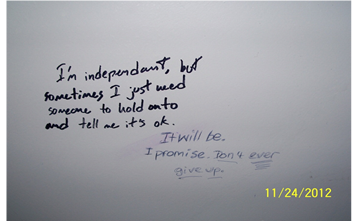Bathroom Graffiti: From phallic doodles and insults to humour, satire and supportive messages
A new article recently published in Gender, Place & Culture examines how men and women express masculinity and femininity in the seemingly private and anonymous spaces of public bathrooms.
The first major study of bathroom graffiti was produced by the famous academic Alfred Kinsey in the 1950’s, which found that many wall inscriptions were highly sexual, but sexuality was defined quite differently among men and women. Whereas men's bathroom graffiti centred on sexual acts and sexual organs, women's graffiti referred to love and relationships in non-erotic terms. Further studies in the 70’s and 80’s suggested that women’s graffiti was becoming more sexual and political, suggesting a lowering of female sexual inhibitions.
In this curious study, 60 years on from Kinsey’s work, Pamela Leong - an assistant professor of Sociology at Salem State University - monitored graffiti in 10 single sex bathrooms; 5 male, 5 female in a US university serving many disadvantaged and low-income students. The text or drawings in the bathroom stalls, while created in a private space and presumably during a very private moment, are meant to be public, as they transmit ideas, images, and even responses.
Leong found that women were more prolific, accounting for 70% of graffiti, at first glance bucking expectation of higher moral conduct. However male graffiti was often overtly sexual, crude, competitive and aggressive; references to sex acts, male and female genitalia and homophobia were frequent, but also more humour as well as some insults. Female graffiti was less sexually explicit; messages were more relationship oriented, confided private thoughts and feelings, as well as messages of support to fellow writers. (See Fig.1) Women often referred to bowel movements, indicating a need to discuss such things privately for fear of being judged ‘dirty’ or unfeminine; a contrast to social acceptance of male lavatorial behaviour.

Fig.1 Graffiti in female bathroom stalls tend to be supportive.
It is known that extreme and irreverent voices are often channelled through graffiti in the absence of a physical audience. Bravado aside, Leong has highlighted stark differences between male and female graffiti which reinforce heterosexual masculine power and female subordination. She notes:
“even in anonymous spaces some people are more equal than others…graffiti… serve to discipline gender through the intolerance of anything feminine…and…reveal relationships of power”.
NOTE TO JOURNALISTS AND EDITORS
Please reference the article as “American graffiti: deconstructing gendered communication patterns in bathroom stalls”, by Pamela Leong, Gender, Place & Culture, 2015, published by Taylor & Francis Group. http://dx.doi.org/10.1080/0966369X.2014.991705
Visit our newsroom at: http://newsroom.taylorandfrancisgroup.com/
Follow us on Twitter @tandfnewsroom
Alan Crompton
MEDIA ENQUIRIES
If you would like further information, please contact:
Alan Crompton
Taylor & Francis Journals
Taylor & Francis Group,
4 Park Square, Milton Park, Abingdon, Oxon, OX14 4RN, UK
Telephone: 44 (0) 207 017 6000
Fax: 020 7017 6713
Email: Alan.Crompton@tandf.co.uk
Website: www.tandfonline.com
-----------------------------------------
About Taylor & Francis Group
-----------------------------------------
Taylor & Francis Group partners with researchers, scholarly societies, universities and libraries worldwide to bring knowledge to life. As one of the world’s leading publishers of scholarly journals, books, ebooks and reference works our content spans all areas of Humanities, Social Sciences, Behavioural Sciences, Science, and Technology and Medicine.
From our network of offices in Oxford, New York, Philadelphia, Boca Raton, Boston, Melbourne, Singapore, Beijing, Tokyo, Stockholm, New Delhi and Johannesburg, Taylor & Francis staff provide local expertise and support to our editors, societies and authors and tailored, efficient customer service to our library colleagues.
Tags:


